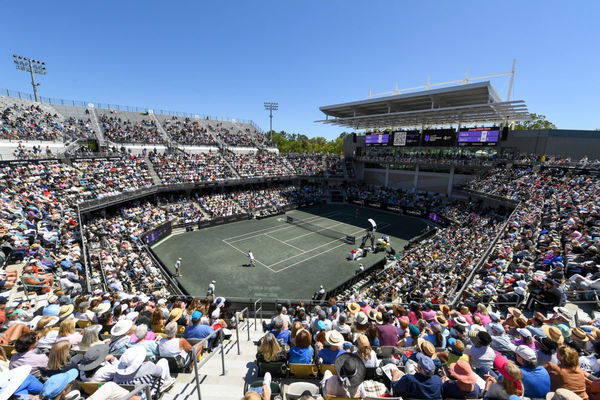

While the red clay surface of Europe and the hard-court surface of America are the two major types of courts prevalent in the professional circuit, there is one more type of court surface that shares the attributes of both courts. The lesser-known green clay courts are mainly used in the junior circuits, but using them more frequently might be beneficial for the pro players as well.
The conversation about the green clay surface in pro circuits has been age-old. Currently, it is only used in one tournament, the WTA Charleston Open. Let’s have a look at what makes green clay the popular choice at this tournament.
ADVERTISEMENT
Article continues below this ad
The transition from America to Europe
The oldest professional all-women’s tournament in America and the only one to be using the much-debated green clay, the WTA Charleston Open acts as a bridge between the fast hard courts of the Sunshine Double and the slower slippery courts across the Atlantic starting at the French Open.
Bob Moran, the director of the Charleston Open says, “Green clay is definitely faster than red clay.” He further adds, “So I think they probably see it as that transition because it is still a little speedier than when they get onto the heavier red clay in Paris.” American women display a preference for green clay, a surface familiar to most from their junior development years. Their comfort level on American clay exceeds that of the European red variety.
Unlike red clay, green clay limits sliding and doesn’t absorb powerful shots as much, aligning well with the Americans’ playing style. This also serves as an organic segue from the hard court to the red clay circuit heading to Europe, where they have been fighting a losing battle for years.
However, there are more benefits to playing on the green clay courts. These surfaces are softer on the joints, resulting in fewer knee and back injuries. Being slower than the hard courts, the green clay courts allow for more athleticism, which helps elevate the overall fitness level of the sport. Let’s have a look at the history of the green clay courts.
Green clay courts were once used at the top level
Although categorized as a clay surface, green clay is comprised of crushed igneous basalt, wherein its distinctive dark grayish-green color is attributed to the mineral epidote found naturally in the stone. Developed in the early 1930s by Har-Tru, a Charlottesville-based company, the green material emerged as a cleaner alternative to traditional red clay courts.
ADVERTISEMENT
Article continues below this ad
An estimated, 16 percent of tennis courts in the United States are clay, and the prevalence of green clay surfaces is particularly notable in the Southeast. In Florida, courts made of green clay outnumber those made of hardcourts. The surface is majorly used for many junior-level United States Tennis Association Pro Circuit Challenger events. Notably three men’s and women’s tournaments whose winners gain the coveted wildcard entry into the French Open.
In the past, green clay courts were even used in top-level American tennis, which is now famously characterized by its hardcourts. From 1975 to 1977, the US Open was played on these green clay courts. However, the tournament transitioned to hardcourts when it shifted location to the Flushing Meadows in 1978.
ADVERTISEMENT
Article continues below this ad
The likes of Rafale Nadal have advocated the change to green clay in America in the past and various tournament directors have portrayed openness in following suit. Nevertheless, what are your thoughts on the Green Clay surface?
Read More: French Open 2024: Rafael Nadal’s Last Dance Leads To Breathtaking 700,000 Demand
ADVERTISEMENT
ADVERTISEMENT
ADVERTISEMENT
ADVERTISEMENT

